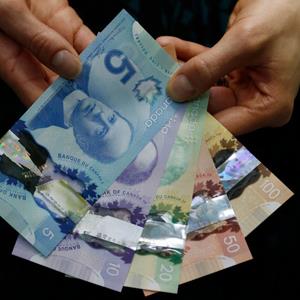Canadians are puzzling over the odor of the country's new plastic bank notes, with some reporting a maple syrup-like smell wafting from the bills. But the Bank of Canada denies adding any scent, according to The Canadian Press.
The mysterious smell came to a boil when the news outlet asked for a year's worth of correspondence sent to the bank about the currency. The first polymer note was issued in 2011, with $5 and $10 bills introduced this year. Dozens of Canadians had contacted the bank about the scent, and some asked whether a scratch-and-sniff patch had been added, according to the bank's records.
The mysterious scent marks the latest controversy for the currency. One botanist earlier this year alleged the Bank of Canada chose the image of a Norway maple -- an invasive species -- for its $20, $50 and $100 bills instead of the native sugar maple, as MSN Money reported in January. (The bank has also denied using the wrong maple, according to The Canadian Press.)
And then there are reports of melting money. One bank teller told the Toronto Star that she had heard of cases in which the plastic bills fused in a hot car.
Given those previous problems, the maple syrup mystery is surely a sweeter issue for the bank to deal with.
Still, not everyone is happy. "The note . . . lost its maple smell," one writer complained. "I strongly suggest the Bank increases the strength of the . . . maple smell."
]
Canadians are puzzling over the odor of the country's new plastic bank notes, with some reporting a maple syrup-like smell wafting from the bills. But the Bank of Canada denies adding any scent, according to The Canadian Press.
The mysterious smell came to a boil when the news outlet asked for a year's worth of correspondence sent to the bank about the currency. The first polymer note was issued in 2011, with $5 and $10 bills introduced this year. Dozens of Canadians had contacted the bank about the scent, and some asked whether a scratch-and-sniff patch had been added, according to the bank's records.
The mysterious scent marks the latest controversy for the currency. One botanist earlier this year alleged the Bank of Canada chose the image of a Norway maple -- an invasive species -- for its $20, $50 and $100 bills instead of the native sugar maple, as MSN Money reported in January. (The bank has also denied using the wrong maple, according to The Canadian Press.)
And then there are reports of melting money. One bank teller told the Toronto Star that she had heard of cases in which the plastic bills fused in a hot car.
Given those previous problems, the maple syrup mystery is surely a sweeter issue for the bank to deal with.
Still, not everyone is happy. "The note . . . lost its maple smell," one writer complained. "I strongly suggest the Bank increases the strength of the . . . maple smell."
Source: http://money.msn.com/now/post.aspx?post=377be5ab-010c-4858-9481-723c1451bd09
I think they're on to something.